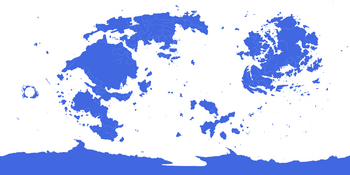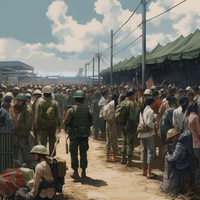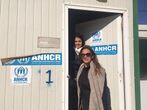Assembled Nations
Assembled Nations | |
|---|---|
Motto: Omnes loqui, nulla actio | |
 Members of the Assembled Nations | |
| Location | Eurth |
| Official languages |
|
| Type | Intergovernmental Organization |
| Membership | 132 Member States |
| Leaders | |
| John Doe | |
• Deputy Secretary | Jane Doe |
| Establishment | |
• AN Charter signed | 1 May 1957 |
• Charter entered into force | 1 January 1958 |
• First assembly meeting | 1 May 1958 |
Website www.an.int | |
The Assembled Nations (AN) is an intergovernmental organization with the goal to further peace and security on Eurth. The AN is made up of almost every country in the wurld. The AN was established after several major conflicts that badly affected multiple continents with an unprecedented scale of destruction, the death of XX million people, and the use of weapons of mass destruction.[1] The dove found on the Assembled Nations' flag and emblem symbolizes the continued endeavour for peace. Its threefold mission is to foster dialogue and cooperation between governments worldwide; to advance international peace and prosperity; and to defend the human rights and individual freedoms of people everywhere. To advance this mission, the Assembled Nations manages many agencies around the Eurth. These include peacekeeping missions, security collaboration projects, human rights campaigns, economic and social development projects, environmental awareness and protection activities, as well as humanitarian missions for populations in crisis.
History
The Assembled Nations (AN) has experienced a complex and dynamic history since its establishment in the mid-20th century. The AN was formed in the wake of major international conflicts, with the intent to foster peace and prosperity on a global scale. Its history is characterised by four distinct periods, each marked by significant events, actions, and changes in public opinion.
Rise (1957-1968)
After a long period of major international conflicts, all countries came together and created the Assembled Nations, an international organisation dedicated to peace and prosperity on a global scale. As the First Argic War (1949-1954) and Long War (1932-1956) came to a close, the majority of the wurld was left shell-shocked and exhausted. No-one wanted to wage a war on such a scale ever again. Many states were convinced that the wurld needed an organisation to ensure peace and stability by setting and enforcing rules that would apply to every member. This was not a new idea. A first concept was proposed as early as 1795 by philosopher Armin Von Kent in his book A Philisophical Proposal for Permanent Pacification. However, many centuries went by before the global leadership created the Charter of the Assembled Nations. This massive milestone was incredibly ambitious, featuring articles that forbade member nations from meddling with the internal affairs of one another or declaring war on each other without arbitration.
After a prolonged period of major international conflicts, all nations convened and founded the Assembled Nations (AN), an international organisation devoted to fostering peace and prosperity on a global scale. This was initiated following the cessation of the First Argic War (1949-1954) and Long War (1932-1956), which left the majority of the wurld shell-shocked and exhausted. The general consensus was a strong desire to prevent such large-scale conflict in the future. This notion was crystallised in the 18th century by philosopher Armin Von Kent (1724-1804) in his book A Philisophical Proposal for Permanent Pacification. However, it took many centuries before the global leadership formed the Charter of the Assembled Nations.
The AN was established with the Treaty of $City in 1957, marking a significant milestone in international diplomacy. The founding charter was ambitious in its scope, featuring articles that forbade member nations from intervening in each other's internal affairs or declaring war without prior arbitration.
Initially, the AN started with $SmallerNumber of founding member countries, which collectively addressed numerous global issues. An array of specialised agencies and commissions was created to further its aims:
- The Disarmament Commission was established to work on reducing the number of weapons worldwide.
- The International Labour Organisation was founded to improve labour conditions.
- The forerunner of ANESCO, an agency dedicated to fostering international cooperation in education, science, and culture, was established, attracting illustrious figures such as !Albert Einstein and !Marie Curie.
- A Central Opium Board was set up to curb the global drug trade.
- The International Court of Justice was instituted to adjudicate disputes between nations.
- A health organisation, later to become the World Health Organisation, was formed to address global health concerns.
- The Slavery Commission was launched to eradicate slavery and the slave trade.
- A committee dedicated to assisting refugees was established.
- Lastly, the Committee for the Study of the Legal Status of Women was founded, championing women's rights globally.
This surge of new bodies increased the AN's power and oversight, enabling it to more effectively address the challenges of the post-war wurld. During this period, the AN was widely respected and trusted by both governments and the general public, setting a strong foundation for its future endeavours.
Failure (1968-1980s)

Despite the ambitious goals and initial successes of the Assembled Nations (AN), the organisation suffered significant setbacks during the late 1960s and 1970s, which greatly damaged its reputation and effectiveness. Despite its mandate to maintain international peace and security, the AN was unable to prevent or mitigate the devastating impacts of the Second Argic War (1968-1974) and the Great Alharun War (1972-1975).
The inability of the AN to prevent these significant conflicts exposed fundamental weaknesses in the organisation's structure and decision-making process. A growing number of member states were able to manipulate the mechanisms of the AN to serve their national interests, undermining the principles of collective security and mutual cooperation. The AN's policy of appeasement was exploited by various nations, causing further disarray in international relations.
The failure to prevent or halt the Second Argic War and the Great Alharun War highlighted the AN's impotence in the face of large-scale conflicts. This had a profound impact on the perception of the organisation both domestically and internationally. Public trust in the AN's ability to maintain peace and protect human rights diminished significantly, and many governments began to question the effectiveness of the institution.
As a consequence of these events, the AN underwent a period of introspection and reform during the late 1970s and early 1980s. Funding was significantly reduced, and many of its functions and powers were re-evaluated. Despite this, the AN managed to endure these trying times and remained committed to its founding principles of promoting peace, prosperity, and human rights on a global scale. However, the failures of this era left a lasting impact, fundamentally reshaping the organisation and its approach to global governance in the years to come.
Irrelevance (1980s-2020s)
Following the period of failure in the late 1960s and 1970s, the Assembled Nations (AN) entered a period of relative irrelevance in the larger context of wurld affairs from the 1980s to the 2020s. This era was marked by increasing global disunity and the growth of unilateral actions by nations, which often acted with impunity and faced little consequence for breaches of international law. The AN's inability to prevent conflicts from erupting reduced its role to managing post-conflict consequences, further undermining its credibility and relevance.
The AN was largely unsuccessful in stopping conflicts before they escalated, and its responses were mostly limited to dealing with post-conflict problems such as refugee management, peacekeeping missions, and recovery from natural disasters. In this context, it was often seen as a reactive body, rather than a proactive one.
Public perception of the AN during this period was largely indifferent, as the organisation's influence on the geopolitical stage waned. However, governments continued to place some level of trust in the AN, relying on it to fulfil its limited duties effectively.
Despite its reduced stature in the sphere of international politics, the AN remained active in humanitarian efforts. It successfully eradicated the slave trade in Alharu and fought against the drug trade in Aurelia. Recognising the growing interconnectivity of the global economy, it also laid the groundwork for the establishment of a Wurld Bank, aimed at promoting economic development and reducing poverty.
Furthermore, the AN focused on public health issues. It assembled experts who studied and wrote extensively about the relationship between food and health. It also launched a massive campaign against infectious diseases such as malaria, which had a significant impact on public health in several regions of the wurld.
Although its relevance in the political arena was diminished during this period, the AN's efforts in the humanitarian and health sectors proved impactful, offering a degree of redemption for the beleaguered organisation.
Return (2020s)

The 2020s marked a resurgence of the Assembled Nations (AN) as a significant player on the global stage. The revival was triggered primarily by the Grand War (2021-2023) among other pivotal wurld events, which underscored the need for effective multinational cooperation and peacekeeping efforts.
The Grand War was a stark reminder of the catastrophic outcomes that could occur in the absence of an effective international body capable of mediation and conflict resolution. In the wake of this conflict, many governments rallied to restore a system of global peace and acknowledged the crucial role of the AN in achieving this aim.
Several nations worked diligently to revitalise the AN, investing in its infrastructure and expanding its mandate to meet the evolving challenges of the 21st century. Efforts were made to increase transparency and accountability within the organisation, and to ensure that it represented the interests of all member states equitably.
During this period, the AN successfully mediated several smaller conflicts, organised and executed large-scale humanitarian missions, and led global initiatives on climate change and sustainable development. In the face of these complex global issues, it became evident that the collective efforts of the AN could yield better results than nations working in isolation.
Public opinion of the AN began to improve during this period as its renewed efforts to foster international peace and cooperation started to bear fruit. Governments also started to view the AN with renewed trust, recognising its critical role in maintaining global stability and addressing shared challenges.
By the end of the 2020s, the AN had re-established its importance as a central figure in the global community, committed to fostering peace, facilitating cooperation, and addressing the pressing issues facing the wurld. This period marked a significant shift in the AN's trajectory, reflecting its resilience and its capacity to adapt to the changing landscape of global politics.
Charter
WIP
Structure
The Assembled Nations[2] encompasses four principal institutions.
- Assembled Council (AC): the primary deliberative body, made up of one representative ambassador from each member nation.
- Security Council (SC): For matters pertaining to issues of peacekeeping and security.
- International Court of Justice (ICJ): the paramount judicial venue that settles legal disputes between nations; advizes on legal questions submitted by the AC.
- Secretariat (SEC): the general executive of the AN. (WIP. Do we really require this institution?)
Agencies
There are numerous other AN-affiliated and related agencies distributed around the wurld. These include:
- ANCAO (AN Civil Aviation Organisation) in Tamworth, Gallambria
- ANCLOS (AN Convention on the Law of the Sea) in $city, $country.
- ANDPO (AN Department of Peace Operations) in $city, $country.
- ANESCO (AN Educational, Scientific and Cultural Organisation) in $city, $country.
- ANHCR (AN High Commissioner for Refugees) in $city, $country.
- ANICEF (AN International Children's Emergency Fund) in $city, $country.
- ANOS (AN Organisation for Standardisation) in $city, $country.
WIP. Here are some other organisations we might have a use for.
- Environmental Research and Protection Organisation in $city, $country.
- Global Bank Group in $city, $country.
- Global Meteorological Organisation in $city, $country.
- International Sea Justice Court in $city, $country.
- World Currency Bank in $city, $country.
- World Food Aid Programme in $city, $country.
- World Health Organisation in $city, $country
First Secretary
The First Secretary of the Assembled Nations (FSAN) is the highest ranking official, responsible for the executive leadership of the organisation. They are the head of the AN Chief Secretariat located in $CityName, $Country. In their role, they are assisted by a deputy and by the director-general of administrative affairs. The FSAN is elected by the organisation's membership to serve a single six-year term.
| No | Portrait | First Secretary[3] (born–died) |
Years in office | Country of origin[4] |
|---|---|---|---|---|
| 1 |  |
Mrs Katya Stănescu (1912-1963) |
1957-1963 | |
| 2 | Mrs Yulia Lemanczyk (1908-1986) |
1963-1969 | ||
| 3 | Mr Johandry Dubert (1922-2003) |
1975-1981 | ||
| 4 |  |
Mrs Arrica Sours (1928-2012) |
1981-1987 | |
| 5 | Mrs Flavia Pierle (1936-2018) |
1987-1993 | ||
| 6 |  |
Mrs Perrine Bergsbaken (1938-2019) |
1993-1999 | |
| 7 | Mr Virgil Chai (1948-2026) |
1999-2005 | ||
| 8 |  |
Mrs Cécile Mychael (1950-2028) |
2005-2011 | |
| 9 |  |
Mr Eriyon Goecker (1958-2039) |
2011-2017 | |
| 10 |  |
Mr Antwayne Zagula (1971-2053) |
2017-2023 |
Membership
Unique among international organizations, every independent sovereign state is considered to be a member. States can decline this by explicitly rejecting their membership. Additionally, any entity judged by the Assembled Council to "exercise stable de facto control over a territory and population" also has a right to membership, even if it is unrecognized by other AN members.
 Abantium
Abantium Adaptus
Adaptus Advocatius
Advocatius Afropa
Afropa Ahrana
Ahrana Akiiryu
Akiiryu Alvernia
Alvernia Anatea
Anatea Andalla
Andalla Ateenia
Ateenia Aurivizh
Aurivizh Ayubi
Ayubi Bainbridge Islands
Bainbridge Islands Baltica
BalticaBashan
 Bruxenburg
Bruxenburg Burkini
Burkini Cabarria
Cabarria Cashar
Cashar Chyrcassia
Chyrcassia Cristina
Cristina Côte de Fourrure
Côte de Fourrure Damak Var
Damak Var Dazhdinia
Dazhdinia Delamaria
Delamaria Deltannia
Deltannia Dolchland
Dolchland Ebrary
Ebrary Elde
Elde Esonice
Esonice Euandria
Euandria Eulycea
Eulycea Faramount
Faramount Feluga
Feluga Fina
Fina Florentia
Florentia Fubukino
Fubukino Fulgistan
FulgistanGaellicia
 Galahinda
Galahinda Greater Galicia
Greater GaliciaGallambria
 Garindina
Garindina Giokto
Giokto Girkmand
Girkmand Gotneska
Gotneska Great Anglia
Great Anglia Great Xio
Great Xio Haruspex
Haruspex Hemahat
Hemahat Hexanesa
Hexanesa Hinterlands
Hinterlands Hugostan
Hugostan Ide Jima
Ide Jima Ionio
Ionio Iverica
Iverica Iwenland
Iwenland Kertosono
Kertosono Kharai
Kharai Kirvina
KirvinaKolhar
 Kotowari
Kotowari Kōri-Chi
Kōri-Chi Littland
Littland Llalta
Llalta Louvier
Louvier Lusuviya
Lusuviya Lysia
Lysia Mahana
Mahana Mantella
Mantella Mekabiri
Mekabiri Mevraq
Mevraq Miiros
Miiros Mito
Mito Nanaviit
Nanaviit Narva
Narva Niederoestereich
Niederoestereich Noble Nykia
Noble Nykia Norrium
Norrium Nyantastan
Nyantastan Orioni
Orioni Per-Aten
Per-Aten Porto Greco
Porto Greco Prymont
Prymont Qubdi
Qubdi Red Iberos
Red Iberos Renolion
Renolion Republic of Dniester
Republic of Dniester Rhava
Rhava Rhodellia
Rhodellia Rohini
RohiniRoqoo
 Safiloa
Safiloa San Ba
San Ba San Giorgio
San Giorgio San Jorge
San Jorge Sanctum Imperium Catholicum
Sanctum Imperium Catholicum Sawbrania
Sawbrania Seylos
Seylos Skrovja
Skrovja Sporsia
Sporsia Stedoria
StedoriaStruma
 Sunset Sea Islands
Sunset Sea Islands Suverina
Suverina Tagmatium
Tagmatium Tamurin
Tamurin Thransaltz
Thransaltz Transbaltia
Transbaltia Uppsund
Uppsund Variota
Variota Vasqqa
Vasqqa Velaheria
Velaheria Volhynia
Volhynia Volsci (withdrawn)
Volsci (withdrawn) Wajoka
Wajoka Walneria
Walneria Yien
Yien Yuropa
Yuropa Zaxar
Zaxar Zharr
Zharr
Former members
Only one member state has left the organization since it was created. This doesn't include member states that have broken up or joined with other member states. In a letter dated 2 April 2019, Volsci informed the Assembled Nations of its decision to withdraw from the AN.[5]
Peacekeeping missions
The AN Department of Peace Operations (ANDPO) is in charge of planning, preparing, managing, and directing peacekeeping operations. In essence, it helps war torn countries create peace. If the parties in a conflict reach a peace treaty, they can ask the AN to help them enforce the peace treaty. If the Security Council approves the request, the ANDPO starts planning the mission. The Peace Legion helps countries navigate the difficult path from conflict to peace. The presence of peacekeepers makes it less likely that there will be another war. AN peacekeepers can include soldiers, police officers, and civilian personnel. They are referred to as the Peace Legion (PLAN).
| Dates of mission | Name of mission | Location | Conflict |
|---|---|---|---|
| 1979–1985 | Assembled Nations Mission in Gotneska (ANMIGK) | Gotneskan Civil War | |
| 1992–1993 | Assembled Nations Mission in Mahana (ANMIM) | Mahanan Civil War | |
| 2006–2009 | Assembled Nations Mission in Zekistan (ANMIZ) | Civil war in Zekistan[6] | |
| 2016–present | Assembled Nations Mission in Afropa (ANMIA) | War on Violetist Liberation Army[7] | |
| 2016–present | Assembled Nations Mission in Bainbridge Islands (ANMIBI) | Meteorolan anti-piracy[8] | |
| 2021–present | Assembled Nations Mission in Wajoka (ANMIW) | 2021-22 Anglian War |
References
- ↑ OOC. Lore to be established. Iverica mentioned there was a nuclear weapon used against Mat Troi Lan (Sunset Sea Islands) during the Thalassan War.
- ↑ OOC. There is also an Assembly of Nations in Aurorum. On 14 January 2022 we checked with User:Concleror to ensure there would be no problem of overlapping names or abbreviations. They responded positively to our proposal. https://discord.com/channels/282995547755905024/374411025983864832/931548778140401706
- ↑ OOC. Gender was decided by random coin flip. Heads is female. Tails is male. https://www.google.com/search?q=flip+a+coin
- ↑ OOC. Historic leadership was decided at random, by picking a random number from the existing Membership list. https://www.wolframalpha.com/input/?i=random+number+between+1+and+111
- ↑ A Word to Europa from the Founder (2 April 2019)
- ↑ Dark times over Zekistan (3 September 2006); Zekistan invasion (12 September 2006)
- ↑ War on Violetist Liberation Army (17 August 2016)
- ↑ The Imperial Navy sets sail, Chapter 3: Preparation (9 April 2019)
External links
- Starting our own Model UN (30 September 2017)
- From Skies to Safety OOC (13 August 2018)
- International organizations (2 March 2020)
- International Peacekeeping Force (21 March 2021)






